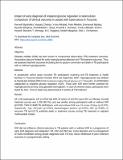| dc.description.abstract | Objective
Diabetes mellitus (DM) has been known to compromise tuberculosis (TB) treatment outcomes. Association data are limited for early hyperglycaemia detection and TB treatment outcomes. Thus, we assessed treatment outcomes including time to sputum conversion and death in TB participants with or without hyperglycaemia.
Methods
A prospective cohort study recruited TB participants receiving anti-TB treatment at health facilities in Tanzania between October 2019 and September 2020. Hyperglycaemia was defined as having pre-existing DM or pre-treatment random blood glucose of ≥7.8mmol/L, in combination categorised as impaired glucose regulation (IGR). Those with IGR were further screened for hyperglycaemia severity using glycated haemoglobin. In case of unknown status, participants were tested for HIV. Time to death was determined at 6 months of TB treatment.
Results
Of 1,344 participants, 187 (13.9%) had IGR, of whom 44 (23.5%) were HIV co-infected. Overall treatment success was 1,206 (89.7%), and was similar among participants with or without IGR (p>0.05). Time to death for participants with and without IGR was 18 versus 28 days (p=0.870), respectively. Age ≥40 years (p=0.038), bacteriological positive (p=0.039), HIV (p=0.009), or recurrent TB (p=0.017) predicted death or treatment success during TB treatment in adjusted multivariable models.
Conclusion
IGR did not influence clinical outcomes in TB patients with or without IGR in a programme of early IGR diagnosis and integration TB, HIV and DM care. Early detection and co-management of multi-morbidities among people diagnosed with TB may reduce likelihood of poor treatment outcomes in a programmatic setting. | en_US |

